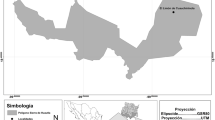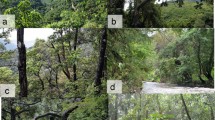Abstract
Ethnobotanical surveys were conducted to locate culturally important, regionally scarce, and disappearing medicinal plants via a novel participatory methodology which involves healer-expert knowledge in interactive spatial modeling to prioritize conservation efforts and thus facilitate health promotion via medicinal plant resource sustained availability. These surveys, conducted in the Maya Mountains, Belize, generate ethnobotanical, ecological, and geospatial data on species which are used by Q’eqchi’ Maya healers in practice. Several of these mountainous species are regionally scarce and the healers are expressing difficulties in finding them for use in promotion of community health and wellness. Based on healers’ input, zones of highest probability for locating regionally scarce, disappearing, and culturally important plants in their ecosystem niches can be facilitated by interactive modeling. In the present study, this is begun by choosing three representative species to train an interactive predictive model. Model accuracy was then assessed statistically by testing for independence between predicted occurrence and actual occurrence of medicinal plants. A high level of accuracy was achieved using a small set of exemplar data. This work demonstrates the potential of combining ethnobotany and botanical spatial information with indigenous ecosystems concepts and Q’eqchi’ Maya healing knowledge via predictive modeling. Through this approach, we may identify regions where species are located and accordingly promote for prioritization and application of in situ and ex situ conservation strategies to protect them. This represents a significant step toward facilitating sustained culturally relative health promotion as well as overall enhanced ecological integrity to the region and the earth.



Similar content being viewed by others
References
Abramiuk MA, Meurer W (2006) A preliminary geoarchaeological examination of ground stone artifacts in and around the Maya Mountains, Toledo District, Belize. Latin American Antiquity 17:335–354.
Arnason J, Cal V, Assinewe V, Poveda L, Waldram J, Cameron S, et al. (2004a) Visioning Our Traditional Health Care: Workshop on Q’eqchi’ Healers Center, Botanical Garden and Medicinal Plant Biodiversity Project in Southern Belize. Final report to IDRC, Ottawa, Canada, 48 pp
Arnason J, Catling P, Small E, Dang P, Lambert J (editors) (2004b) Biodiversity & Health: Focusing Research to Policy, Ottawa, Canada: NRC Research Press.
Balick M, Nee M, Atha D (2001) Checklist of Vascular Plants of Belize, with Common Names and Uses, New York: New York Botanical Garden Press.
Bateson J, Hall I (1977) The Geology of the Maya Mountains, Belize (Overseas Memoir 3), London, UK: Her Majesty’s Stationery Office.
Berlin B (1992) Ethnobiological Classification: Principles of Categorization of Plants and Animals in Traditional Societies, Princeton, NJ: Princeton University Press.
Buenz E (2005) Country development does not presuppose the loss of forest resources for traditional medicine use. Journal of Ethnopharmacology 100:118–123.
Carpenter GA, Gjaja MN, Gopal S, Woodcock CE (1997) ART neural networks for remote sensing: vegetation classification from Landsat TM and terrain data. IEEE Transactions on Geoscience and Remote Sensing 35:308–325.
Conklin H (1954) The Relation of Hanunóo Culture to the Plant World. Unpublished PhD dissertation in anthropology, New Haven, CT: Yale University.
Cressie N (1993) Statistics for Spatial Data: Revised Edition, New York: John Wiley and Sons.
Cullen BS (2000) Contagious Ideas: On Evolution, Culture, Archaeology, and Cultural Virus Theory Oxford, UK: Oxbow Books.
Davis W (1999) Clouded Leopard, Vancouver, BC: Douglas and MacIntyre Publishing Group.
Davis F, Goetz S (1990) Modeling vegetation pattern using digital terrain data. Ecology 4:69–80.
Dixon C (1956) Geology of Southern British Honduras with Notes on Adjacent Areas, Belize City, Belize: Government Printing Office.
Dougherty J (1978) Salience and relativity in classification. American Ethnologist 5:66–79.
Farnsworth N, Akerele O, Bingel A, Soejarto D, Guo Z (1985) Medicinal plants in therapy. Bulletin of the World Health Organization 63:965–981.
Grimes B (1996) Ethnologue: Languages of the World, 13th ed., Dallas: Summer Institute of Linguistics.
Guisan A, Zimmermann N (2000) Predictive habitat distribution models in ecology. Ecological Modelling 135:147–186.
Hammond N, Clarke A, Belli FE (1992) Middle preclassic Maya buildings and burials at Cuello, Belize. Antiquity 66:955–964.
Hanski I (2005) Landscape fragmentation, biodiversity loss and the societal response. EMBO Reports 6:388–392.
Hartshorn G, Nicolait L, Hartshorne L, Bevier G, Brightman R, Cal J, et al. (1984) Belize, Country Environmental Profile, Trejos Hnos, San Jose, Costa Rica
Hebb DO (1949) The Organization of Behavior: a Neuropsychological Theory, London: Chapman and Hall.
Herman JF, Blomquist SL, Klein CA (1987) Children’s and adults cognitive maps of very large unfamiliar environments. British Journal of Developmental Psychology 5:61–72.
Hirtle SC, Jonides J (1985) Evidence of hierarchies in cognitive maps. Memory and Cognition 3:208–217.
Holland JH (1975) Adaptation in Natural and Artificial Systems, Ann Arbor, MI: University of Michigan Press.
Housley RA, Hammond N, Law IA (1991) AMS radiocarbon dating of preclassic Maya burials at Cuello, Belize. American Antiquity 56:514–519.
Ironmonger S, Leisnerm R, Sayre R (1995) Plant records from the natural forest communities in the Bladen Nature Reserve, Maya Mountains, Belize. Caribbean Journal of Science 31:30–48.
Lake MW (1998) Digging for memes: the role of material objects in cultural evolution. In: Cognition and Material Culture: The Archaeology of Symbolic Storage, Renfrew C, Scarre C (editors), Cambridge, UK: University of Cambridge, McDonald Institute for Archaeological Research, pp 77–88.
Maffi L (2001a) Language, knowledge, and indigenous heritage rights. In: On Biological and Cultural Diversity, Maffi L (editor), Washington, DC and London, UK: Smithsonian Institution Press, pp 412–432.
Maffi L (editor) (2001b) On Biological and Cultural Diversity, Washington, DC and London, UK: Smithsonian Institution Press.
Meerman JC, Clabaugh J (editors) (2007) Biodiversity & Environmental Resource Data System (BERDS). Available: http://www.biodiversity.bz (v. October 2007)
Myers N, Mittermeier R, Mittermeier C, da Fonseca G, Kent J (2000) Biodiversity hotspots for conservation priorities. Nature 403:853–858.
Pesek T, Cal M, Cal V, Fini N, Minty C, Dunham P, et al. (2006a) Rapid ethnobotanical survey of the Maya Mountains range in southern Belize: a pilot study. Trees for Life Journal 1:1–12.
Pesek T, Helton L, Nair M (2006b) Healing across cultures: learning from traditions. EcoHealth Journal 3:114–118.
Pesek T, Cal V, Fini N, Cal M, Rojas M, Sanchez P, et al. (2007) Itzama: revival of traditional healing by the Q’eqchi’ Maya of southern Belize. HerbalGram 76:34–43.
Royle J, Link W, Sauer J (2001) Statistical mapping of count survey data. In: Predicting Species Occurrences: Issues of Scale and Accuracy, Covello, CA: Island Press
Shennan S (2002) Genes, Memes, and Human History: Darwinian Archaeology and Cultural Evolution, London: Thames and Hudson Ltd.
Sperber D (1979) Explaining Culture: A Naturalistic Approach, Oxford, UK: Blackwell Publishers Ltd.
Stepp J, Castaneda H, Cervone S (2005) Mountains and biocultural diversity. Mountain Research and Development 25:223–227.
Sutherland W (2003) Parallel extinction risk and global distribution of languages and species. Nature 423:276–279.
Takagi H (2001) Interactive evolutionary computation: fusion of the capacities of EC optimization and human evaluation. Proceedings of the IEEE 89:1275 –1296.
Treyvaud-Amiguet V, Arnason J, Maquin P, Cal V, Sanchez-Vindaz P, Poveda L (2005) A consensus ethnobotany of the Q’eqchi’ Maya of southern Belize. Economic Botany 59:29–42.
United Nations Food and Agricultural Organization (2000) Global Forest Resources Assessment, 2000. FAO Forestry Paper 140. http://www.fao.org/forestry/fo/fra/main/ (accessed August 3, 2005)
World Health Organization (2002) WHO Traditional Medicine Strategy 2002–2005, Geneva, Switzerland: World Health Organization.
World Wildlife Fund (2004) Living Planet Report 2004, Gland, Switzerland: World Wildlife Fund.
Acknowledgments
This work was supported by Cleveland State University, College of Science, and the Naturaleza Foundation.
Author information
Authors and Affiliations
Corresponding author
Additional information
T.P. designed study, conducted data collections and analysis, and largely wrote the paper. M.A. advised and assisted with study design, data collections and analysis and contributed heavily to the paper in the knowledge and cognitive sections and the writing thereof. D.G. developed algorithms for spatial evolutionary computation-based predictive modeling and applied them in study design, performed spatial statistical analysis and contributed heavily to sections on interactive spatial predictive modeling, study design, results and the writing thereof. N.F. assisted with study design, data collections, analysis, and mapping. J.M. assisted with study design and covariate data. V.C. assisted with on site coordination. All authors discussed results and commented on the manuscript.
Rights and permissions
About this article
Cite this article
Pesek, T., Abramiuk, M., Garagic, D. et al. Sustaining Plants and People: Traditional Q’eqchi’ Maya Botanical Knowledge and Interactive Spatial Modeling in Prioritizing Conservation of Medicinal Plants for Culturally Relative Holistic Health Promotion. EcoHealth 6, 79–90 (2009). https://doi.org/10.1007/s10393-009-0224-2
Received:
Revised:
Accepted:
Published:
Issue Date:
DOI: https://doi.org/10.1007/s10393-009-0224-2




